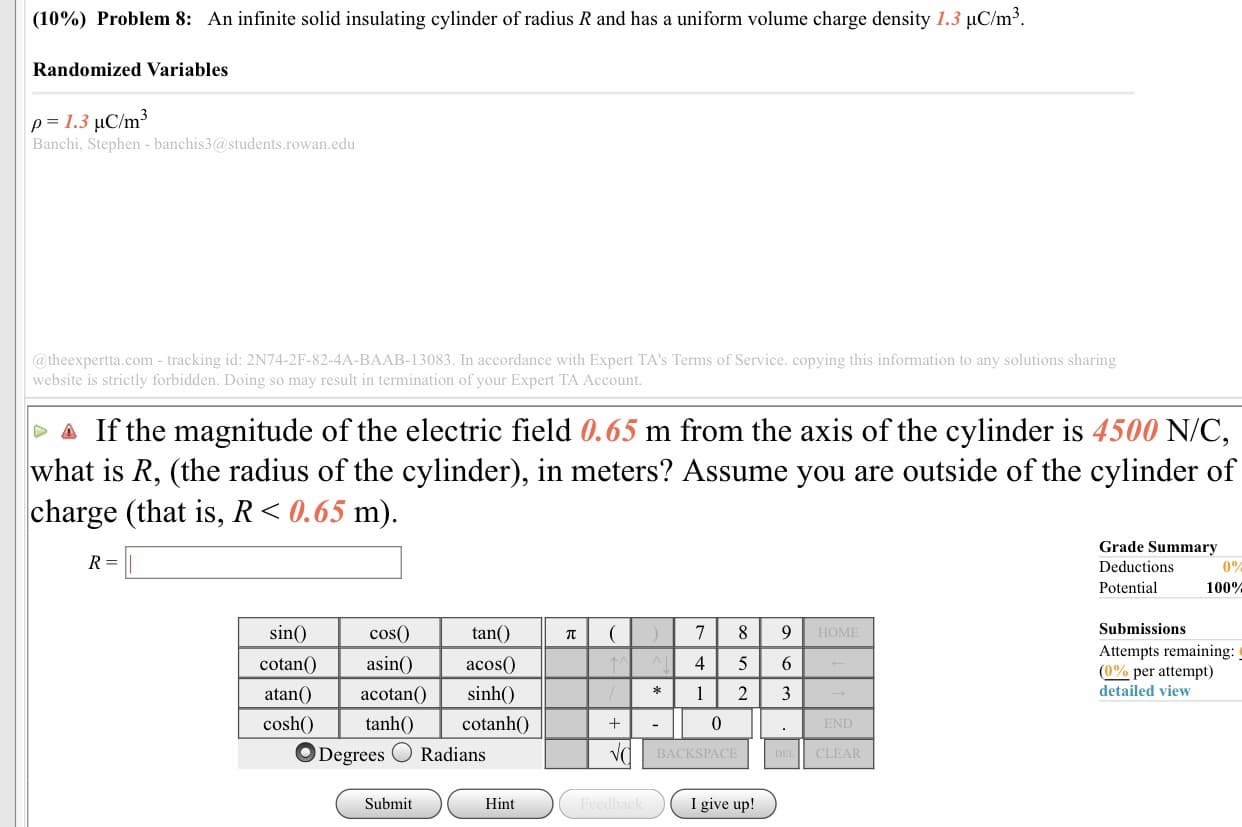(10%) Problem 8: An infinite solid insulating cylinder of radius R and has a uniform volume charge density 1.3 μC/m Randomized Variables Banchi, Stephen- banchis3@students.rowan.edu @ theexpertta.com - tracking id: 2N74-2F-82-4A-BAAB-13083. In accordance with Expert TA's Terms of Service. copying this information to any solutions sharing website is strictly forbidden. Doing so may result in termination of your Expert TA Account. If the magnitude of the electric field 0.65 m from the axis of the cylinder is 4500 N/C what is R, (the radius of the cylinder), in meters? Assume you are outside of the cylinder of charge (that is, R < 0.65 m) Grade Summary Deductions Potential 100% cos(0 tan( Submissions sin() cotanasi atan()acotan( acos() sinh() Attempts remaining: (0% per attempt) detailed view 4 5 6 *1 23 0 osh tanh0 cotanh Degrees C) Radians BACKSPACE CLEAR Submit Hint I give up!
(10%) Problem 8: An infinite solid insulating cylinder of radius R and has a uniform volume charge density 1.3 μC/m Randomized Variables Banchi, Stephen- banchis3@students.rowan.edu @ theexpertta.com - tracking id: 2N74-2F-82-4A-BAAB-13083. In accordance with Expert TA's Terms of Service. copying this information to any solutions sharing website is strictly forbidden. Doing so may result in termination of your Expert TA Account. If the magnitude of the electric field 0.65 m from the axis of the cylinder is 4500 N/C what is R, (the radius of the cylinder), in meters? Assume you are outside of the cylinder of charge (that is, R < 0.65 m) Grade Summary Deductions Potential 100% cos(0 tan( Submissions sin() cotanasi atan()acotan( acos() sinh() Attempts remaining: (0% per attempt) detailed view 4 5 6 *1 23 0 osh tanh0 cotanh Degrees C) Radians BACKSPACE CLEAR Submit Hint I give up!
Related questions
Question

Transcribed Image Text:(10%)
Problem 8:
An infinite solid insulating cylinder of radius R and has a uniform volume charge density 1.3 μC/m
Randomized Variables
Banchi, Stephen- banchis3@students.rowan.edu
@ theexpertta.com - tracking id: 2N74-2F-82-4A-BAAB-13083. In accordance with Expert TA's Terms of Service. copying this information to any solutions sharing
website is strictly forbidden. Doing so may result in termination of your Expert TA Account.
If the magnitude of the electric field 0.65 m from the axis of the cylinder is 4500 N/C
what is R, (the radius of the cylinder), in meters? Assume you are outside of the cylinder of
charge (that is, R < 0.65 m)
Grade Summary
Deductions
Potential
100%
cos(0
tan(
Submissions
sin()
cotanasi
atan()acotan(
acos()
sinh()
Attempts remaining:
(0% per attempt)
detailed view
4 5 6
*1 23
0
osh tanh0 cotanh
Degrees C) Radians
BACKSPACE
CLEAR
Submit
Hint
I give up!
Expert Solution
This question has been solved!
Explore an expertly crafted, step-by-step solution for a thorough understanding of key concepts.
This is a popular solution!
Trending now
This is a popular solution!
Step by step
Solved in 6 steps with 5 images
